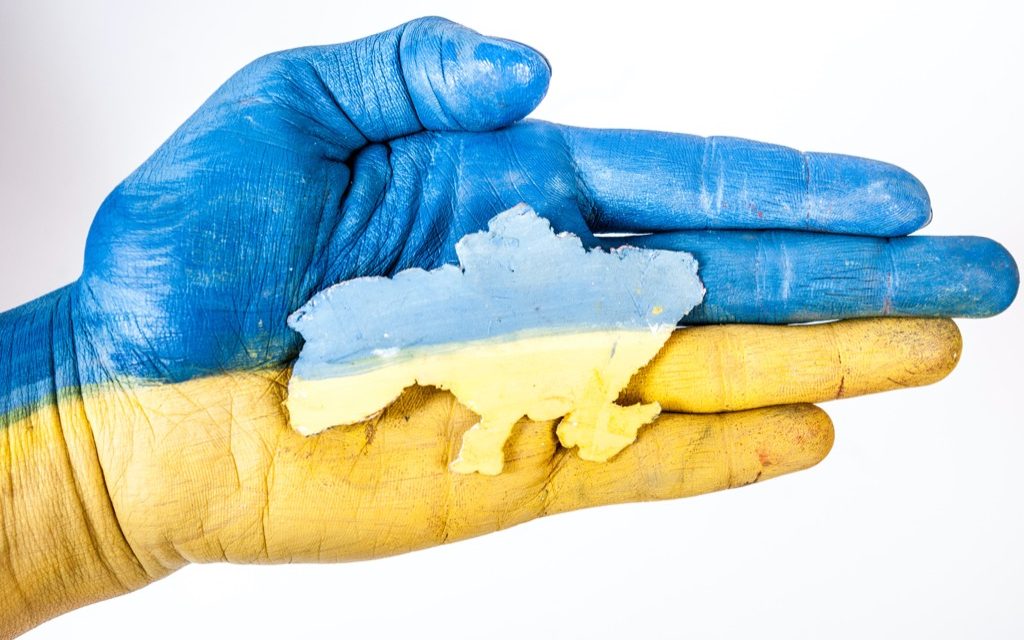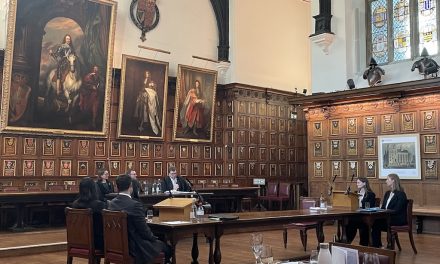Russia invaded Ukraine on Thursday 24 February 2022. It looks increasingly likely that the war will be a protracted one. More than eight million Ukrainians have fled their country and many more have been internally displaced. Too many lives have been destroyed. Villages, towns, and cities like Mariupol, a port city of about 400,000 people has been flattened to allow Russian-backed separatist forces into the eastern parts of Ukraine. Yet still, the people of Ukraine fight for freedom and continue to resist a full-scale Russian occupation.
After the successful annexation of Crimea in 2014, Russia started preparing for war in the autumn of 2021. It established extensive military operations along the border of Belarus which the onlookers observed through satellite images. There were so-called ‘military drills’, that consisted of amassed tanks, troops, and lethal weaponry during which time the international community focused its efforts on tense dialogues between Moscow, Washington, EU countries and beyond. These were pursued in a fervent bid to avoid a conflict.
All attempts to curtail Russia’s military objectives failed: Western ties strengthened, while Russia turned to Cold War allies. In the corridors of the White House and the EU, lively debates about the kind of economic and trade sanctions likely to have the greatest impact on Russia dominated political agendas. The primary aim was to bring back international peace and security, whilst preserving Ukraine’s sovereignty and territorial integrity.
Before the start of the Winter Olympics in Beijing, days before the invasion, António Guterres, the United Nations Secretary General, called for an ‘Olympic Truce’. A dogmatic yet clearly aspirational principle of the modern Olympics. The ‘Olympic Truce’ was clearly not going to present itself as an insurmountable hurdle for President Vladimir Putin who weighed in the balance his options as this major sporting event drew to a close.
It was not the first time that Putin had breached the ‘Olympic Truce’; In 2014, after the Winter Olympics in Sochi, Russian troops rolled nonchalantly into Crimea to annex the peninsula from the rest of Ukraine. In response to Russia’s aggression then, sanctions were issued and adopted. Yet apart from the banks, regulators and a few other interested parties, nobody really took much notice of them, and they had limited impact.
When Russia invaded Ukraine on Thursday 24 February 2022 though, not only did the world change overnight but so too did people’s knowledge about sanctions. Now they are spoken about in cafes, round the dinner table, in courtrooms, on the news and even in classrooms when inquisitive young minds ask questions about geopolitics to do with this drawn-out war.
Sanctions are not new though. Trade restrictions were first used in 1962 against Cuba by the US in response to the Cuban Missile Crisis and remain in place today. They were used against South Africa in 1963 as part of an international effort to unravel the apartheid regime. Over the years, sanctions have been used to tackle all kinds of crises. They may be imposed unilaterally by individual states like the US or by the international community on a multilateral basis through the United Nations or the European Union. They are often referred to as ‘restrictive measures, economic restrictions, financial sanctions, trade, and export control measures as well as embargoes’. Taken collectively, sanctions are prohibitions that may even bind all 193 UN member states if they are adopted by the UN Security Council acting under the authority of Chapter 7 of the UN Charter or 27 Member States if imposed by the EU.
Sanctions have endured a chequered history and have generated a complex body of law. They reached their highpoint in 2022 when they were used for the first time against a major global economic player, Russia. Prior to this and after the lethal attacks of 9/11, for over a decade, they were used by the international community to tackle terrorism.
A short summary of the key developments from 2000 to the present day
Sanctions dominated the UN Security Council’s agenda. The Security Council is authorised to take whatever measures it decides are necessary to maintain or restore international peace and security. At this time, the UN relied heavily on the imposition of asset freezes and travel bans on individuals and entities. These restrictive measures resulted in names being added to a consolidated list with the requirement that all UN member states freeze, ‘without delay’, the funds and other financial assets or economic resources of the designated individuals and entities. The purpose of these sanctions was to restrict a terrorist’s access to funds and prevent them from travelling. Household names like Osama Bin Laden, Al-Qaeda and the Taliban all featured on these lists. It remains an open question whether they were successful or not.
By 2006, a new era of sanctions was emerging because the threat posed by Iran’s nuclear programme had seized the agenda of the Security Council and the focus on terrorism became slightly less important. In June 2010, President Obama worked with Congress to pass the Comprehensive Iran Sanctions, Accountability and Divestment Act of 2010 (CISADA). This Act produced the first comprehensive and unilateral sanctions regime enacted by the US. It was developed to strengthen existing US sanctions against Iran. It was aimed at curtailing Iran’s access to the international financial system and was swiftly reflected in UK law as the UK government bowed to pressure exerted by the US to frustrate Iran’s nuclear programme. These sanctions are commonly referred to as the ‘nuclear regime’ imposed against Iran.
In 2011, sanctions changed again. The central feature of the 2011 sanctions landscape was the international community’s response to the civil uprisings across the Arab world. Although the Arab Spring was acted out in different ways, a variety of internal measures were pursued to quell the uprisings. However, one thing all these countries had in common was a novel type of sanctions used to preserve the vast sums of misappropriated state funds. In Egypt, Libya and Syria, sanctions were introduced to identify and freeze assets which had been taken unlawfully from the public purse. The primary objective was to hunt down eyewatering sums, concealed by well-known dictators like Colonel Ghaddafi. These sanctions are typically referred to as the ‘misappropriation regimes’. They targeted the sovereign wealth funds of these countries, sometimes valued at over $100 billion, and involved funds held outside of the Arab world. They resulted in the funds ultimately being frozen then and remaining frozen today.
By 2014, there was a shift away from ‘misappropriation regimes’. Agreement on how to tackle Iran allowed some space for the international community to confront Russia at an EU level, and unilaterally by the US, in response to its illegal annexation of Crimea. In March 2014, the EU Council introduced a new sanctions regime, strongly condemning the annexation of Crimea and the city of Sevastopol to the Russian Federation. Alongside the US and other Western states, the EU introduced far reaching, creative and complex economic, trade and financial restrictions against Russia. The new sanctions introduced in 2014 went significantly beyond what had previously been imposed, restricting Russia’s access to capital markets and banning the export of dual use goods and certain technologies to the country in a bid to frustrate Putin’s illegal landgrab.
2016 was the year of the Iran nuclear deal when the Joint Comprehensive Plan of Action (JCPoA) was agreed by the permanent members of the UN Security Council and the EU. It was the culmination of many years of diplomatic efforts to encourage Iran to turn is military nuclear programme into a peaceful one in exchange for sanctions relief.
Whilst there was a lot going on in 2017 to do with Syria and the enduring humanitarian crisis, there were also large-scale efforts driven by EU institutions, economic operators, and banks to uphold the Iran nuclear deal. Additionally, there was considerable focus on North Korea which resulted in this year bringing a degree of cohesion to the international community’s foreign policy objectives.
2018 was marked by a high pace of change: the Trump administration managed a major shift away from stability, further fracturing the diplomatic relationship between the US and EU. This was the year when the US withdrew from the JCPoA and unsurprisingly, amongst many other diplomatic efforts to uphold the deal, the EU fought back with a robust political and legal plan to preserve the fragile international agreement.
By 2019, the US had increased pressure on Venezuela, the UK had passed more and more Brexit related sanctions legislation and Trump’s maximum pressure campaign on Iran resulted in a ratcheting up of all sanctions. Meanwhile, the EU tirelessly attempted to breathe life into the nuclear deal coming up with responsive measures like the EU Blocking Regulation to counter the effects of US sanctions as well as a bespoke trade mechanism called INSTEX to encourage trade with Iran.
In 2021, restrictive measures against the Belarusian regime were adopted by the EU as part of its response to escalations of serious human rights violations and the violent repression of civil society, democratic opposition, and journalists. These restrictions targeted the imports to Belarus of equipment, technology and software used to monitor communications as well as imposing trade restrictions on the export of tobacco, petroleum, and potassium chloride.
Shortly after the introduction of restrictive measures against Belarus, the Taliban swept across Afghanistan in just 10 days. They took control of Kabul by Sunday 15 August 2021 and new sanctions were imposed in yet another jurisdiction.
Currently, there are over 30 EU sanctions regimes in place. In the UN there are 14 ongoing regimes, and the US has 38 active regimes ranging from rough diamond trade controls to cyber related sanctions, with measures imposed against countries like Mali and the Central African Republic. None of these compare however to the unprecedented magnitude of the sanctions imposed against Russia since the start of its war waged against Ukraine.
Russia is now the world’s most sanctioned country ever. It dominates the agendas of the EU, the US and UK and its sanctions programme towers above even the most prohibitive regimes like North Korea, Syria, and Iran.
On the first anniversary of the war, the EU imposed its tenth package of sanctions against Russia. Over 1400 individual designations and 200 entities have been targeted so far. For the first time, sanctions have become more tangible as household names such as Roman Abramovich have seen their premier league football clubs like Chelsea sold because of sanctions. Measures have hit yachts in the Maldives, villas in Tuscany, global fertilizer companies and airline companies like Aeroflot which has been abandoned or grounded planes because of international sanctions that target Russia’s wealthy elite. The supporters of Putin and sectors which are key to the survival of its economy. Russian banks in the West have collapsed or been shut out of the international payment system, SWIFT. Russian bonds have plummeted, golden visas have been revoked and even high street names in the UK like Holland & Barrett – known for nationwide sales of organic berries, vitamin supplements and herbal tea – have faced challenges because of complex ownership structures which can be traced back to sanctioned beneficial owners like Petr Aven and Mikhail Friedman.
Adding to the existing measures imposed in 2014, since Russia’s full-scale invasion of Ukraine, sanctions have been imposed against government and military officials, banks, the aviation and maritime sectors, Russia’s wealthy elite, commodities including oil, coal, steel gold, cement, wood, and luxury goods like vodka, caviar, tobacco, and cars. Even Harrods has put up a sign to inform its customers that, if Russian, no goods worth more than £300 are sold to comply.
Export control measures have been introduced to restrict Russia’s access to cutting edge technology, dual use goods, machinery, and transportation equipment. The EU, US and UK have targeted the services sectors to prevent Russia from accessing services previously provided by Western companies. This includes restrictions on the provision of consultancy, IT, accounting, tax, trust, engineering, and legal advisory services to Russia. The overarching objective of all these measures has been to shut Russia out of the international financial system and cripple its economy whilst at the same time hampering its ability to manufacture the critical goods that contribute to its war effort.
Yet, the war drags on and the devastation continues, begging the question as to whether the sanctions are effective in impacting Russia. It goes without saying that there will always be conflicting views on this, but much of the debate around whether they are working stems from a lack of clarity about their goals. Let’s be clear, Western countries never intended to use sanctions to stop Putin from invading Ukraine. Sanctions would never have forced him to back down nor can they persuade him to pull out of Ukraine. Equally, the sanctions imposed are not aimed at provoking regime change in Moscow. That hasn’t worked in Syria, North Korea, or Cuba.
The stark reality is that sanctions take time to take effect. As layer upon layer of measures are imposed, leaving no sector untouched, these restrictive measures gradually seep into the economy and slowly impact all industries by eroding their effectiveness and undermining their efficiency.
All this makes it harder for Russia to access what it needs to intensify its military capabilities and grow its economy. It is arguable that Russia has managed to prop up the Ruble and withstand the initial shock of sanctions, but it has lost vast imports from the West and is struggling to meet its domestic needs with substitutions. The International Monetary Fund (IMF) estimates that its imports fell by 19.2% whilst at the same time its aviation sector has almost collapsed. Of course, there are countries which are picking up the trade gaps and coming to Russia’s rescue, but there are signs that these measures are inflicting economic pain on Russia, most notably, according to the IMF, its economy is shrinking.
There is mounting evidence that Russia is successfully evading some of the sanctions to find alternative supply chains and beat the restrictions. It’s been widely reported that Russia is importing breast pumps, refrigerators, PlayStations and washing machines to extract the basic components needed for drones and other devices because of the semi-conductors this equipment hosts. Russia is also finding evasive techniques to bypass export control measures and import the critical goods it needs to continue its war effort.
Whilst there is plenty of evidence to support the argument that sanctions are not achieving their goal in full, equally, the fact that Russia is having to pay more for goods, the fact that it cannot easily access the international financial system, or the services usually provided by Western service providers is certainly a strong sign that sanctions are making it tougher and much more costly for the regime to fund its war.
This year’s priority for those countries opposed to the war is to tackle circumvention of the measures and enforce them on an industrial scale. Near the top of the political agenda is also significant work being undertaken (driven primarily by President Zelenskyy’s office) to find lawful ways to go beyond just freezing assets. The aim now is to seize lawfully the assets that have been frozen, with a view to channel them into a reconstruction fund for Ukraine. At the end of last year, EU Commission President Ursula von der Leyen confirmed her plans to use €300 billion frozen Russian Central Bank reserves to reconstruct Ukraine. Finding a legal way to do this poses a significant challenge that has yet to be resolved.
Sanctions will not end the war, but they are part of the solution.
Note: information correct at time of writing

Chloe Cina is a barrister and the Head of Global Sanctions Advisory at Deutsche Bank. She is recognised globally by regulators and the private sector as a thought leader and international financial sanctions expert. She has worked at the UN, the UK Foreign & Commonwealth Office and HSBC.



